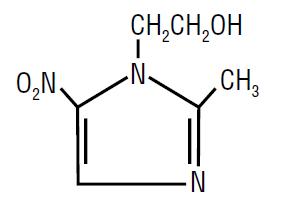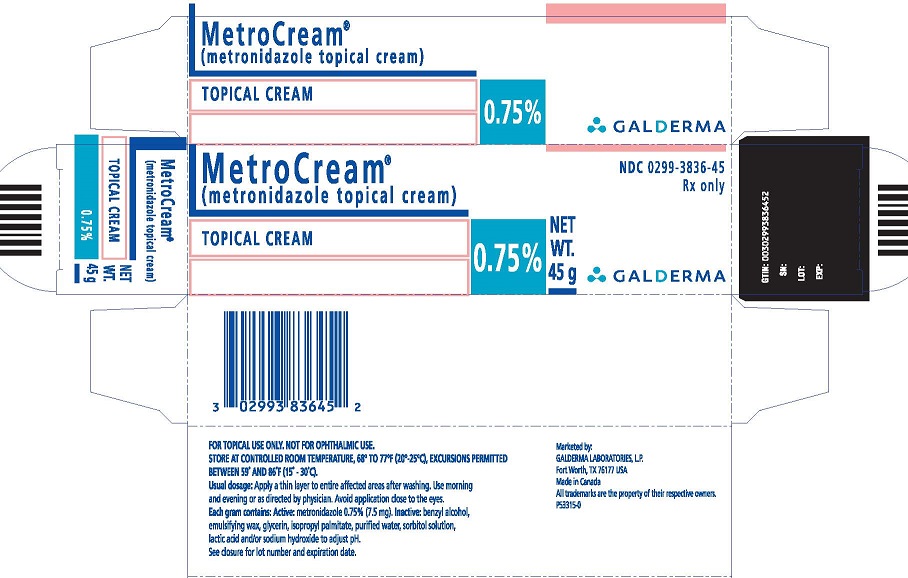Label: METROCREAM- metronidazole cream
- NDC Code(s): 0299-3836-45
- Packager: Galderma Laboratories, L.P.
- Category: HUMAN PRESCRIPTION DRUG LABEL
- DEA Schedule: None
- Marketing Status: New Drug Application
Drug Label Information
Updated June 26, 2018
If you are a consumer or patient please visit this version.
- Download DRUG LABEL INFO: PDF XML
- Official Label (Printer Friendly)
-
DESCRIPTION:
METROCREAM® Topical Cream contains metronidazole, USP, at a concentration of 7.5 mg per gram (0.75%) in an emollient cream consisting of benzyl alcohol, emulsifying wax, glycerin, isopropyl palmitate, purified water, sorbitol solution, lactic acid and/or sodium hydroxide to adjust pH. Metronidazole is a member of the imidazole class of antibacterial agents and is classified therapeutically as an antiprotozoal and anti-bacterial agent. Chemically, metronidazole is 2-methyl-5-nitro-1 H-imidazole-1-ethanol. The molecular formula is C6H9N3O3 and molecular weight is 171.16. Metronidazole is represented by the following structural formula:

- CLINICAL PHARMACOLOGY:
- INDICATIONS AND USAGE:
- CONTRAINDICATIONS:
-
PRECAUTIONS:
General: Topical metronidazole has been reported to cause tearing of the eyes. Therefore, contact with the eyes should be avoided. If a reaction suggesting local irritation occurs, patients should be directed to use the medication less frequently or discontinue use. Metronidazole is a nitroimidazole and should be used with care in patients with evidence of, or history of blood dyscrasia.
Information for patients: This medication is to be used as directed by the physician. It is for external use only. Avoid contact with the eyes.
Drug interactions: Oral metronidazole has been reported to potentiate the anticoagulant effect of warfarin and coumarin anticoagulants, resulting in a prolongation of prothrombin time. The effect of topical metronidazole on prothrombin time is not known.
Carcinogenesis, mutagenesis, impairment of fertility: Metronidazole has shown evidence of carcinogenic activity in a number of studies involving chronic, oral administration in mice and rats but not in studies involving hamsters.
Metronidazole has shown evidence of mutagenic activity in several in vitro bacterial assay systems. In addition, a dose-response increase in the frequency of micronuclei was observed in mice after intraperitoneal injections and an increase in chromosome aberrations have been reported in patients with Crohn’s disease who were treated with 200-1200 mg/day of metronidazole for 1 to 24 months. However, no excess chromosomal aberrations in circulating human lymphocytes have been observed in patients treated for 8 months.
Pregnancy: Teratogenic effects: Pregnancy category B: There are no adequate and well-controlled studies with the use of METROCREAM® (metronidazole topical cream) Topical Cream in pregnant women. Metronidazole crosses the placental barrier and enters the fetal circulation rapidly. No fetotoxicity was observed after oral metronidazole in rats or mice. However, because animal reproduction studies are not always predictive of human response and since oral metronidazole has been shown to be a carcinogen in some rodents, this drug should be used during pregnancy only if clearly needed.
Nursing mothers: After oral administration, metronidazole is secreted in breast milk in concentrations similar to those found in the plasma. Even though blood levels are significantly lower with topically applied metronidazole than those achieved after oral administration of metronidazole, a decision should be made whether to discontinue nursing or to discontinue the drug, taking into account the importance of the drug to the mother.
Pediatric use: Safety and effectiveness in pediatric patients have not been established.
-
ADVERSE REACTIONS:
In controlled clinical trials, the total incidence of adverse reactions associated with the use of METROCREAM® Topical Cream was approximately 10%. Skin discomfort (burning and stinging) was the most frequently reported event followed by erythema, skin irritation, pruritus and worsening of rosacea. All individual events occurred in less than 3% of patients. The following additional adverse experiences have been reported with the topical use of metronidazole: dryness, transient redness, metallic taste, tingling or numbness of extremities and nausea.
-
DOSAGE AND ADMINISTRATION:
Apply and rub in a thin layer of METROCREAM® (metronidazole topical cream) Topical Cream twice daily, morning and evening, to entire affected areas after washing.
Areas to be treated should be washed with a mild cleanser before application. Patients may use cosmetics after application of METROCREAM® (metronidazole topical cream) Topical Cream.
-
HOW SUPPLIED:
METROCREAM® (metronidazole topical cream) Topical Cream, 0.75% is supplied in a 45 g aluminum tube - NDC 0299-3836-45.
Storage conditions: STORE AT CONTROLLED ROOM TEMPERATURE, 68° to 77°F (20° to 25°C), EXCURSIONS PERMITTED BETWEEN 59° AND 86°F (15° - 30°C).
Marketed by:
GALDERMA LABORATORIES, L.P.
Fort Worth, Texas 76177 USA
Made in Canada
All trademarks are the property of their respective owners.
P53314-0
Revised: January 2017 -
PACKAGE LABEL:

MetroCream®
(metronidazole topical cream)TOPICAL CREAM
0.75%
NET WT. 45 g
NDC 0299-3836-45
Rx only
GALDERMA
FOR TOPICAL USE ONLY. NOT FOR OPHTHALMIC USE.
STORE AT CONTROLLED ROOM TEMPERATURE, 68° TO 77°F (20°-25°C), EXCURSIONS PERMITTED BETWEEN 59° AND 86°F (15° - 30°C).
Usual dosage: Apply a thin layer to entire affected areas after washing. Use morning and evening or as directed by physician. Avoid application close to the eyes.
Each gram contains: Active: metronidazole 0.75% (7.5 mg). Inactive: benzyl alcohol, emulsifying wax, glycerin, isopropyl palmitate, purified water, sorbitol solution, lactic acid and/or sodium hydroxide to adjust pH.
See closure for lot number and expiration date.
Marketed by:
GALDERMA LABORATORIES, L.P.
Fort Worth, TX 76177 USA
Made in Canada
All trademarks are the property of their respective owners.
P53315-0 -
INGREDIENTS AND APPEARANCE
METROCREAM
metronidazole creamProduct Information Product Type HUMAN PRESCRIPTION DRUG Item Code (Source) NDC:0299-3836 Route of Administration TOPICAL Active Ingredient/Active Moiety Ingredient Name Basis of Strength Strength Metronidazole (UNII: 140QMO216E) (Metronidazole - UNII:140QMO216E) Metronidazole 7.5 mg in 1 g Inactive Ingredients Ingredient Name Strength Benzyl Alcohol (UNII: LKG8494WBH) Glycerin (UNII: PDC6A3C0OX) Isopropyl Palmitate (UNII: 8CRQ2TH63M) Water (UNII: 059QF0KO0R) Sorbitol (UNII: 506T60A25R) Lactic Acid (UNII: 33X04XA5AT) Sodium Hydroxide (UNII: 55X04QC32I) Packaging # Item Code Package Description Marketing Start Date Marketing End Date 1 NDC:0299-3836-45 1 in 1 CARTON 09/20/1995 1 45 g in 1 TUBE; Type 0: Not a Combination Product Marketing Information Marketing Category Application Number or Monograph Citation Marketing Start Date Marketing End Date NDA NDA020531 09/20/1995 Labeler - Galderma Laboratories, L.P. (047350186) Establishment Name Address ID/FEI Business Operations DPT Laboratories, Ltd. 832224526 manufacture(0299-3836) Establishment Name Address ID/FEI Business Operations Galderma Production Canada Inc 251676961 manufacture(0299-3836)

